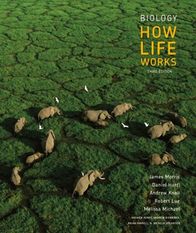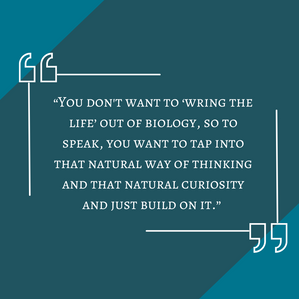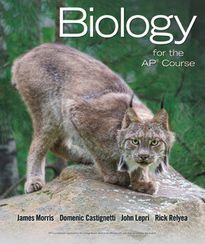Sparking Wonder with Macmillan Learning Author Jim Morris
- Subscribe to RSS Feed
- Bookmark
- Subscribe
- Printer Friendly Page
- Report Inappropriate Content
At Macmillan Learning, we recognize that the success of our textbooks and courseware is in large part due to our outstanding authors. We want to offer students and instructors an opportunity to get to know these extraordinary authors, whose remarkable careers and interests often extend far beyond higher education. While many are distinguished professors and academics at some of the most reputable colleges, universities, and institutions around the world, there’s often a very interesting career path that they have taken to get to where they are today.
Such is the case with Dr. James (Jim) Morris, co-author of Biology: How Life Works and professor at Brandeis University, which is
Dr. Morris’ genuine enthusiasm for teaching was immediately apparent when I began our interview, as he thanked me for helping foster an interest in learning and science. He struck me as the kind of professor I always appreciated in college: one who is more interested in teaching scientific thinking and problem solving than the memorization of an encyclopedia of terms
Throughout our conversation, we spoke about his unlikely career path that ultimately brought him to teaching and authoring, what it’s like to author a text from scratch, how teaching has evolved over the years, and why biology and (more broadly) science, is for everyone.
We are all science people. Science is all around us.
Dr. Morris loves teaching biology to all students, but he’s particularly interested in teaching those who are not majoring in biology. “I want to get through to the students who don't see themselves as science people,” he noted, and then paused. “Let me put it another way -- we are all science people.”
Science can be described as the systematic study of the physical and natural world through observation and experiment. We all have a body and experience chemical and anatomical processes. “If you really want to understand something about yourself, you have to understand something about biology.” Knowing and understanding how our own body works is just one of the many aspects to the vast study of biology. The various aspects of biology and the natural world are all around us with plants, animals, issues like climate change and even the pandemic, he explained. It’s more than that though, we naturally think scientifically.
He offered an example to illustrate this point: imagine that the light goes out. You may think that it’s the light bulb that went out, and by doing that you have formed a hypothesis. It’s a scientific term for the guess that you naturally came up with. By switching the light bulb out to see if that works, you’re testing the hypothesis. If swapping the bulb doesn’t bring the light back on, you’re on to the next hypotheses.
“I think we're all naturally curious about the world,” he said. That tracks with his philosophy to have students leave his classes more interested in learning about how the world works. “You don't want to ‘wring the life’ out of biology, so to speak, you want to tap into that natural way of thinking and that natural curiosity and just build on it.” And that needs to start prior to a college education. Students can become overwhelmed, or overly focus on the quantitative data in a course, resulting in them claiming they are not a “science person,” but science is about more than that. It’s about being curious, asking questions, and observing. “I think those are exactly the people I am trying to reach.”
He added that it's with those students in mind that he develops his textbook resources. He wants to foster a love of science not in spite of the textbooks, but rather because of them, which he noted, is a tall order because “nobody generally likes a textbook.” He and the How Life Works team strive to make the materials engaging, topical, contemporary, and -- importantly -- not overwhelming as students are learning this material.”
Medicine is based on science but there’s a lot of pattern recognition. And so is biology.
Dr. Morris is interested in many things; among them are evolution, genetics, epigenetics, the history of science, and science education. He’s currently a teacher, a learner and a researcher. But in his long and interesting career, he’s also been a doctor, a teacher at a high school for deaf students, and more. He has a PhD in genetics and an MD from Harvard. His passion? Well, that’s all about teaching biology and the sciences. And his path to becoming a top instructor at Brandeis was what he described as a “long and meandering one.” And it was certainly unexpected.
He noted that his own high school biology teacher was an inspiration to him on his journey to learn about biology (this acknowledgement can be found in Biology for the AP Course). While he originally pursued a biology degree, being in “one of these very large lecture classes” dissuaded him from that path. He ultimately finished his undergraduate degree in History and Science -- a unique degree that combines history, science and the history of science -- where he enjoyed the smaller classes, was given mentorship, and had many opportunities to hone his writing skills. His love of teaching and learning led to a position teaching deaf children and studying sign language at the National Institute for Deaf Children in Paris, France.
It was there that he recognized how much he loved teaching; so much so, that it sparked his interest in pursuing his MD. He explained that medicine is based in science and has a scientific underpinning. “As a practicing doctor it's a lot of pattern recognition. You're putting pieces together and forming a picture, and science is really about asking questions that we don't know the answer to. They're related, but distinct.”
Medical school offered him a broad scientific education, learning about anatomy, physiology, genetics, chemistry, microbiology, and more. In medical school he also learned a new way of teaching, which focused less on lecturing and more on problem solving, case studies, and working together in small groups, and learning through peer to peer instruction.
Dr. Morris had an opportunity to work in a small lab with “a fantastic mentor” to ask and answer questions about flies and epigenetics, which examines how the context of a gene - in a chromosome, nucleus, cell, organism, and environment - affects gene expression. So, how a gene is turned on or off. He really enjoyed this work as well as being in an academic setting; it led to him to apply to an MD/PhD program and ultimately earning both degrees at Harvard. He spent the next 20 years on a “meandering path” of postdoctoral work, internships and toggling between research and medicine. He was already working on How Life Works when he settled into his role at Brandeis, which he chose because he could teach, run a small lab and author the textbook. “I remember thinking that, you know, I found my home.”
It all came together in a marvelous way for the physician scientist. “I kept gravitating towards teaching,” he noted. “I can absolutely see in retrospect how much my exposure to different kinds of education and my own training and working with so many people set me up well to think about science, education, and even textbook writing.”
The key (to writing a book) is starting from scratch
Similar to how the classroom itself has changed to become more engaging, so have the materials that students use. To reflect those changes, it’s not just an author sitting down and writing anymore. There are writers, but there are also many other authors including a media team, a team working on assessments and activities, videos and simulations and editors working in parallel to pull it all together. Jim is clear that How Life Works is a team effort between the author team and Macmillan Learning and Bedford, Freeman, & Worth editorial groups.
Writing a book is different than it was many years ago, he noted, because students use content differently than they have in the past. As it turns out, course materials are not just for reading anymore. When Dr. Morris and the team envisioned How Life Works about 15 years ago, they threw out the textbook, so to speak, and started from scratch. “The textbooks were, in some ways, out of date. They were up to date in the latest science, but they weren't modern in terms of how students learn.” He explained that the typical textbooks of the past had been encyclopedic and long, which made sense before advances like Wikipedia and the internet.
The book’s goal was to move away from an emphasis on terms and facts, and instead convey concepts and ways of thinking that scientists use to understand the world around them and solve contemporary problems. To do that, they rethought everything, including how much content to include, how to organize it, the best ways to include questions from learning and assessments, how to innovate with media, and how all of it should be integrated together to tell the story of how life works. Their goal was to do this all in a way that engages and doesn’t overwhelm the learner. The process yielded ideas like how to make better use of media by using a Google map-like interface to have students explore a cell, digital animations that were created by fellow author, Robert (Rob) Lue.
Students are good at learning modular facts, the challenge is connecting them. And that is the story of biology.
I asked Dr. Morris whether there were differences between the writing process for his college students and for high school students. (Dr. Morris currently authors two textbooks, Biology: How Life Works and Biology for the AP Course.) Without hesitation, he remarked “it really was completely different.”
Because the college version of How Life Works was very engaging and visually oriented, the team originally thought it wouldn’t be that much work to create a high school version of the text. But after considering the existing levels of knowledge, different curriculum, order in which students learned the topics, it was back to the drawing board for Dr. Morris and the How Life Works team. He used his previous knowledge as a high school teacher, partnered with the Bedford, Freeman, & Worth high school editorial team and worked with a few high school biology teachers as advisers on the new text. For him, it was both a fun and meaningful project.
Writing for high school students is more like writing for a general audience, he noted. “You go from first principles. You go slowly and you tell it in different ways.” It’s repeating information without being repetitive, but rather by approaching the topics from different angles. Ultimately that line of thinking and writing resulted in a modular organization, composed of smaller and more focused blocks of material to build a foundation of knowledge and create context.
The way the foundation was built within the text was designed to help students continue to build connections and scaffold and layer information upon it. And, ultimately, to place what they just learned within the broader context of biology. “You can find that students are pretty good at learning individual facts and the challenge is connecting them. And that is the story of biology.”
The History of Life Wall
This brings us back to the History of Life Wall that I’ve heard so much about from my colleagues. It wraps up his experiences and passions into an example that lives on in the halls of Brandeis. The History of Life wall was a project curated by his undergraduate students who were inspired by one of his visual demonstrations about the timespan of the planet’s formation to modern day. Dr. Morris explained how, when you walk down the history of life, you see so many familiar events crowd at the end of the timeline. And that it gives you “a very visceral, tangible sense of things that are hard to convey by just talking about it.”
There's more than one way to do this. He used to use a roll of paper towels in his demonstrations and he also points me to a video that demonstrates the evolution of life condensed into 60 seconds. He welcomes these active ways of experiencing science that exist at the intersection of science and art. “It’s an informal science education that takes place outside of the classroom, when you may not even recognize that you’re learning about science.” Indeed, we are all science people. Both born of science and imbued with the natural curiosity of a scientist. The engaging walk seems pretty symbolic of Dr. Morris’ career -- offering an unexpected path of life itself, but made to spark curiosity and wonder in those who pass by.
One last point about that wall: “I want students to leave with a sense of both scale and really where we are in the history of life. It's about your place in the universe, but it's your place in time.”








